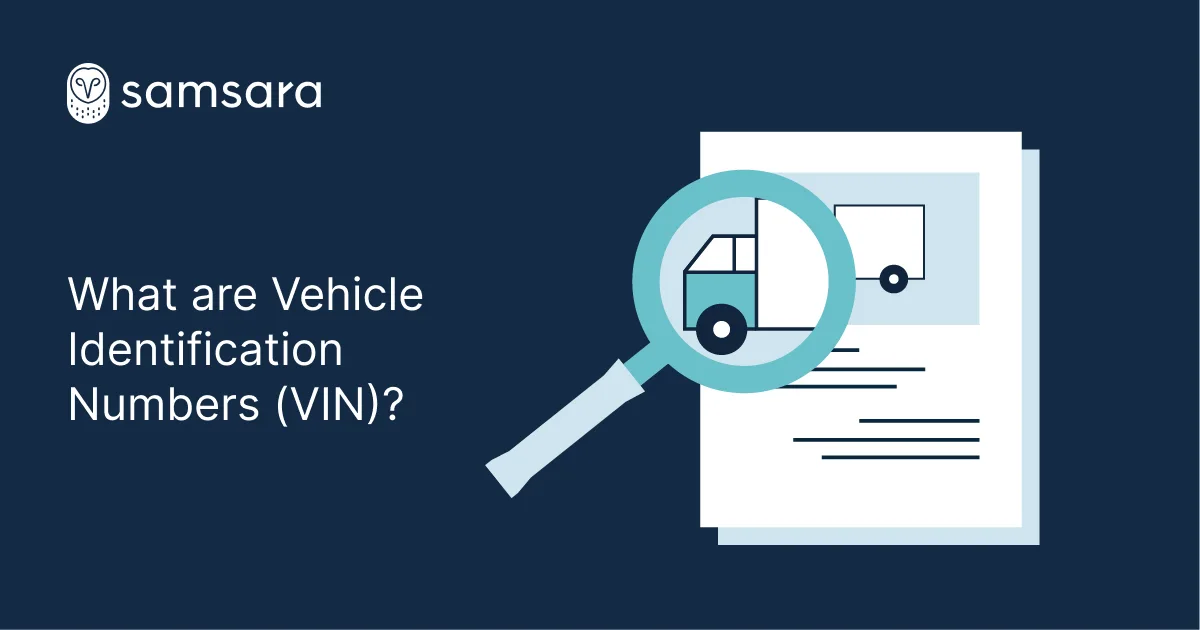What is a Vehicle identification number (VIN)?
October 22, 2021

Get Started With Samsara
Check Our PricesKey Takeaways
Vehicle identification numbers (VIN) are important numbers used to track registrations, warranties, safety recalls and insurance. But those numbers and letters aren’t randomized. Learn how to locate your VIN number and to decode each digit.
What is a vehicle identification number (VIN)?
A vehicle identification number (VIN) is a unique alphanumeric sequence used by the automotive industry to identify a specific vehicle. They are similar to social security numbers for vehicles.
A VIN number displays the vehicle type, country of origin, specifications, and manufacturer. It’s used to track registrations, warranties, safety recalls, and insurance. Both consumers and businesses can perform a VIN lookup to get a wide range of data on the title, airbag type, engine size, vehicle history report, liens and other useful information.
Where can you find the vehicle identification number?
There are several places to find a vehicle’s VIN. On the vehicle, check:
Lower left (driver’s side) corner of the dashboard
Under the hood on the front of the engine block
The front-end of the frame in older vehicles
Driver’s side door on a sticker (inside the doorjamb)
Outside of the motor vehicle, the VIN is found on the:
Vehicle title
Registration
Auto insurance documents
Some manufacturers and dealerships offer VIN etching on windows and windshields to prevent theft.
VIN standardization
VINs were first used in the U.S. in 1954 to identify motor vehicles. However, there was no accepted standard for these numbers, so they came in a wide array of configurations and variations depending on the manufacturer.
Beginning with the model year 1981, the National Highway Traffic Safety Administration (NHTSA) standardized the format. (The NHTSA is an agency under the U.S. Department of Transportation or DOT) The agency required that all over-the-road vehicles sold must contain a 17-character VIN. Before 1981, VIN numbers varied in length from 11 to 17 digits.
Vehicle identification numbers do not include the letters O, I, and Q to avoid confusion with numerals 0, 1, and 9.
Decoding VIN numbers and letters
While a truck or car’s VIN may seem like random numbers and letters, they are composed of an organized sequence. VIN information is organized into groups of data. Some of the digits are easily found information, such as the world manufacturer identifiers (WMI). Others are held by the manufacturer and require more digging to decode. Each vehicle manufacturer publishes a VIN decoder to look up what each digit represents in their makes and models.
The first group consists of world manufacturer identifiers:
Digit 1: The country of origin
Digit 2: The vehicle manufacturer
Digit 3: When combined with the first two digits, the third digit identifies the vehicle’s type or manufacturing division
The next six digits (digits 4-9) are the vehicle descriptor section.
Digits 4-8: Vehicle model, body style, transmission, and engine type
Digit 9: This is a manufacturer’s security code. It’s used to detect invalid VINs.
The last eight digits (digits 10-17) are the vehicle identifier section. These numbers are assigned on the assembly line when the vehicle is made.
Digit 10: The model year of the vehicle
Digit 11: This is the assembly plant where the vehicle was manufactured. Each automaker has its own set of plant codes.
Digits 12-17: This is the vehicle’s unique serial number